For those people participating in the discussion on Google + tomorrow I just wanted to let you know that I will be inviting you to participate in a "hangout" a few minutes before the discussion is scheduled to begin. You will need to be on Google + to see and join this hangout. If for some reason you don’t see it, go to hangouts on the left side of the screen. Once you get to the hangouts screen you’ll see hangouts to join and this one should be there! If you haven’t used hangouts before, you need to try one between now and when we start so that you can be sure your computer is set up properly.</d
Author: jeffgillman003
Update on Google +
For all of you getting ready to participate with us on Google + on Thursday I need to get you into our circle, so if you could either search for me on Google + and friend me, or, alternatively, e-mail me (gillm003@umn.edu) and let me know you want to participate, that will be necessary for your participation.
We are planning to record this session and make it available on you-tube (assuming I can figure out all the technology).
I have been told by a few people that my scheduling stinks because many of you work. I hear you loud and clear! Next time we’ll try to do this in the eveni
Get Ready for Something New
Over the past week the garden professors have been playing with something new, and we think it’s time to try it live with all of you.
Hopefully some of you are aware of Google and Google +. On Google + there is a feature called “Hangouts” which lets you interact directly with up to ten people at once using camera and microphone. More than that can participate by watching the discussion (though I’m still working that out on my computer — it should be ready by the time we go live.)
Next Thursday August 30 at 11:20 Eastern, 10:20 Central, 9:20 Mountain, and 8:20 Pacific time we’re going to start a hangout on Google + and invite all of you to join. Then we’re going to start a live discussion.
The topic of the discussion is related to, but not exactly the same as, Bert’s somewhat controversial post from last week — “Should the government be able to require you to plant natives on your own land.”
As a side note, if you want to read how the Florida Native Plant Society responded to that post please read this. Wow! Even though the topic we’ll be discussing doesn’t deal with Bert’s post directly, hopefully someone (or a few people) from the FNPS will join us. I’ll drop a comment onto their blog to make sure they at least know about the opportunity.
We are open to tangents in the discussion. We want this to be open ended, fun, and informative.
So what do you need to do if you want to participate? For right now the thing to do would be to get a google + account. Just go here. Also, if you don’t have a camera or microphone hooked up to your computer — now would be a good time to do that. We’d also appreciate it if you’d comment on this post to let us know that you are planning on participating (or want to participate but can’t make it). Please keep in mind that if we don’t have much participation we probably won’t try this again — at least not for awhile.
We’ll provide more instructions and information on the blog as we get closer to next Thursday. We’re looking forward to this and hope that many of you can join us.
Injecting Gels Into The Soil — Good Idea?
It recently came to my attention that the Sierra Club published an article on a new system for reducing watering in lawns. You can read it here. Basically what the company, AquaCents, does is inject a polyacrylamide gel into the landscape and then the gel supposedly collects irrigation and/or rain water and releases it for plants to take up as the landscape dries.
I think it’s a good concept, but I’m highly skeptical that this is a good product for two reasons. The first is that I’ve used polyacrylamide gels to hold water for plants before and have found no benefit. In fact, most papers out there on the topic show either no benefit or marginal benefit from using these gels in terms of increasing the amount of water available to plants – though I must admit that results are variable.
Please note that I didn’t say I was skeptical that the polymer will hold lots of water – I’m not. It will hold lots of water.
Which leads us to an important question. If we know that the gel will hold water, and this company has done testing which shows reduced watering is required in lawns that use this technology, then why am I skeptical?
Based on what I have read and the experiments I’ve done, I think the company’s testing isn’t telling the whole story.
As far as I can tell, what they’re doing to test this product is injecting it into lawns and then allowing a moisture detector in the lawn to trigger sprinklers to go on when soil moisture falls below a certain level. If you test one lawn with the polymer side by side against another lawn without the polymer, then the lawn with the polymer will use less sprinkler water because the gel holds more water than the surrounding soil – meaning that it stays more moist. So at this point it sure seems like the gel is a good idea — right?
No, because this experiment asked the wrong question. It looked at how much water was in the lawn, NOT HOW MUCH WATER WAS GETTING TO THE PLANT. And that’s what we need to know – how much water gathered up in that gel will actually get to the plant. What I’ve found in my work is that having water in the gel is not the same as getting water to the plant. The gel seems to hold the water too tightly for the plant to get it. It’s a little like having an impenetrable safe filled with five million dollars in gold. Sure, the gold is there, but if you can’t get to it, who cares?
So, why does the grass seem to be growing more roots when the gel is used? My best guess is that the lawns were overwatered in the first place and the gel just provided a way for homeowners to decrease their watering. Let’s face the facts, overwatering of lawns is rampant.
But I mentioned that there were two reasons why I didn’t like the gel. I named the first, so what’s the second? It’s something that I saw on one of Linda’s sites a few years ago and then looked into a little further. Polyacrylamide gel, while relatively safe in and of itself, may break down into more toxic substances. See Linda’s article here.
Finally – and this is just a thought — there are plenty of other absorbent materials out there that might be injected into the ground, including some made of starch – I have tried gels made of starch and have found them to be as effective as those made of polyacrylamide (though I know that’s not saying a lot). Or…maybe we should just water more judiciously. Like I said, just a thought.
Bagging Fruit
One of the recommendations that I always make when I discuss organic methods that work is bagging fruit. If you’ve never heard of it then here’s the story. By placing a bag of some sort around your fruit, such as apples or peaches, when they’re young you can protect them from insects and disease. I used to recommend plastic ziplock bags (up here in the North anyway), and I still do, they’re cheap and work well. You can also purchase Japanese fruit bags that will work. But recently I was introduced to a more streamlined product which I really like — a cloth pocket with a cord to close off the top. Since it’s made out of cloth it probably won’t protect against disease as well as plastic bags or Japanese fruit bags, but if insects are your main concern then I think these might be just perfect for you — if you don’t mind paying a few dollars for them (they are reusable!)
At a master gardener conference I recently attended one of the vendors handed me some of her Startbagging fruit bags to test on tomatoes. I say test because, while these bags have been pretty effective at protecting tree fruits, they haven’t been used much for veggies (OK, OK, a tomato is technically a fruit). To be honest though, I’m not as worried about insects on tomatoes as I am deer. The deer near me don’t seem to care for the plants themselves, but they just love to pick the tomatoes off when they’re almost, but not quite ripe. Jerks.
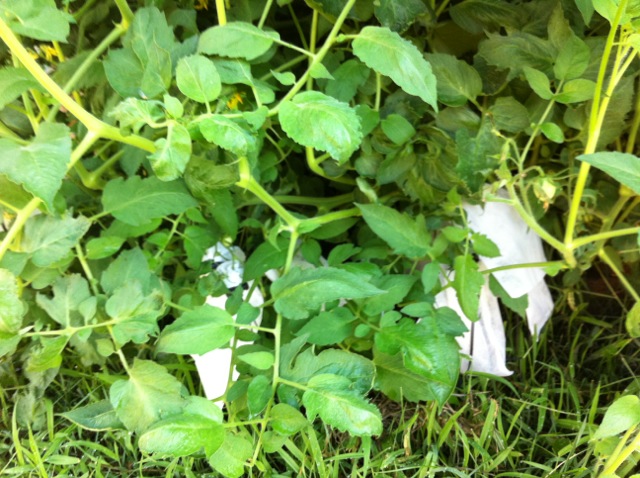
Here are a few bags on a tomato plant.

Here’s a closeup of one of the bags.
I’ve only had these bags on the plant for about a week now — so far so good. The company producing these bags is a small start-up. From what I understand these bags are patent pending. I wish this company well because I think this is organic pest control at its best — reusable products that don’t utilize chemicals. If you have any interest you can go to startbagging.com to take a look (the website is a little basic right now — hopefully they’ll fix that soon!).
A Tip from Jerry Baker
Linda’s posting this week made me nostalgic for some good old garden guru advice, so I couldn’t help but zip on over to Jerry Baker’s web site (www.jerrybaker.net) to see if he had anything interesting to tell me. I wasn’t disappointed! Here is one of his recommendations:
Three-minute eggshells
“Place eggshells in the microwave for three minutes, remove, crush into a fine powder, and place them in a cloth sachet. Then drop the sachet into your houseplant watering can to give your indoor plants a nice nitrogen-boost.”
Wow! how about that! Eggshells for a nitrogen boost! Who woulda thought…. Anyway, after I saw this, I got to thinking, maybe, just maybe, there might be some nitrogen there…..
So I microwaved four eggshells, crushed them, and put them into a half-liter of water, then let them sit in the water for about 9 hours. Then I filtered the water off and ran that water (along with a control sample) over to our soils lab to be tested.
And wouldn’t you know it? That water DID have nitrogen in it! About 5 parts per million! Which is about 1/10th of what I would consider even close to a fertilizer application….So then if we do the math, that would mean that eighty egg shells per liter (about a quart) would make a decent shot of nitrogen.
Sorry Mr. Baker, I just don’t eat that many eggs.
I’m Burnin, I’m Burnin, I’m Burnin For You! — A Short Story Told With Pictures
To those of you who don’t like Blue Oyster Cult, I’m sorry, I just couldn’t stop myself.
A couple of weeks ago I mentioned that I spend some time flame weeding. It’s a technique for getting rid of weeds by frying them using a 500,000 BTU (I’m not kidding – that’s how powerful this thing is rated) torch hooked up to a propane tank. It’s not something I do a lot, just something that I get the urge to do periodically — when I need to feel macho.
Here’s the blow by blow – it’s kind of a good news, bad news story.
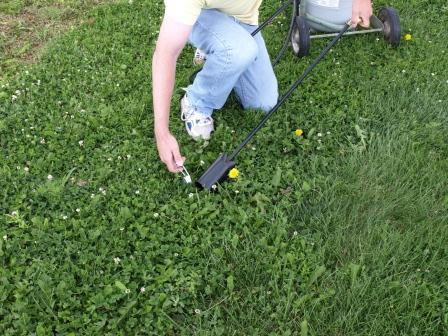 a Good news – Igniting the propane torch was quick and straightforward process. The torch lit on the first try!
a Good news – Igniting the propane torch was quick and straightforward process. The torch lit on the first try!

Bad news – Here’s my hairless finger after igniting the torch. Even though the process of igniting the torch was quick and easy, I still burned all of the hair off of the fingers on my right hand. The black dots are all that’s left of my fantastic finger fuzz.
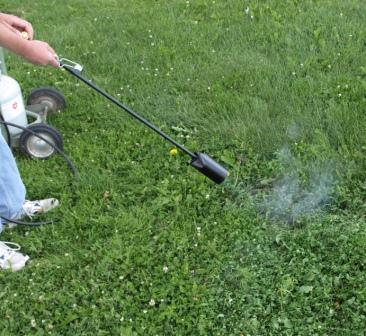
Good news – Damn but I feel powerful using this thing! It’s like holding a jet engine in your hands! Yes, it does make me feel macho.
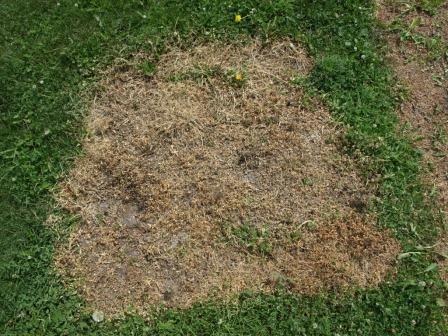
More good news – only a couple of days later the plot looks almost spotless!
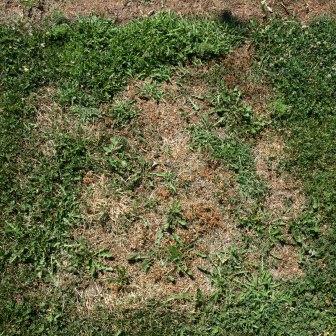
Bad news – Two weeks later the perennial weeds are already on their way back. The ground insulates the roots too well.
Bud Markhart
Tuesday morning I started the day by going outside, lighting a propane torch, and doing a little bit of flame – weeding for a demonstration. Then I went inside, answered a few e-mails, and worked on a paper. Around 4:00 I decided to go get a haircut because Wednesday I was due to speak before a portion of the Minnesota congress, along with a Professor in the department of Plant Pathology, to seek funding for a project that we have which identifies Dutch elm disease resistant elms in Minnesota.
In short, up until about 4:00 on Tuesday, I was feeling pretty darn professorial not to mention highly important.
Then, just before I headed out the door, an e-mail came across my computer screen, letting our department know that Bud Markhart had passed away.
For those of you who didn’t know Bud, he was a professor in the Department of Horticultural Science here at the University of Minnesota. He was a plant physiologist who also did a lot of lecturing and work with organics. He taught, among other things, a hands-on organic production course.
His passing wasn’t a surprise. He was only 60, but he’d been fighting cancer for a few years and all of us in the department were aware that he probably didn’t have much time left. Still, it hurts to lose someone like him.
As I’ve gone through my academic career I’ve had the opportunity to meet a lot of academics. To make an unfair generalization, we tend to be self-righteous, self-important, and highly critical of others. Bud was none of these things, and because of that he was loved and respected by many people both inside and outside of academia, but especially by students who were deeply appreciative of a professor who treated them as equals and didn’t talk down to them. He earned the highest teaching award presented by the University of Minnesota, the Morse Alumni Teaching Award, a couple of years ago. But the fact that he taught a class this past spring despite his illness reveals more about his commitment to students than any award could.
Personally, well, this is the guy who invited my wife and I to his house for Thanksgiving the first year that I lived in Minnesota. In fact, he’s the guy who invited my Dad and me over my first day in Minnesota.
I think that a lot of people who talk about the recently departed refer to themselves as being closer to the departed than they actually were, and I don’t want to do that. Bud and I were colleagues and, though I considered Bud a friend, we weren’t particularly close. Still, I always knew that Bud’s door was open if I ever wanted to talk about anything. He cared about people and he let it show. His presence in our department, and in the small world that is horticulture, will be sorely missed.
This Really Bugs Me
I get things wrong sometimes – I’ve had slip ups when speaking and said things I didn’t intend to say. I’ve written things that I wish I had the chance to rewrite because I explained things poorly. I’ve even gotten my facts mixed up from time to time. Still, it bothers me when someone who should know better delivers information that is blatantly wrong.
Yesterday I was looking at YouTube videos regarding compost tea. As anyone who has ever looked up compost tea on YouTube knows, if you look long enough you’ll eventually come to videos of Dr. Elaine Ingham. She’s one of the biggest proponents of compost tea out there and is also Chief Scientist at the Rodale Institute. Here’s a link to one of the videos that I ended up watching. Interestingly, it doesn’t have much to do with compost tea.
http://www.youtube.com/watch?v=GEtl09VZiSU
To be fair, she makes some excellent points in the video about people needing to conserve the life in soil. And I did like her basic definition of soil and dirt at the beginning.
Other points aren’t as well made. As I was viewing this video I heard something that really ticked me off.
Go to 9:20 on the video and watch for a couple of minutes. Listen to the insights about wartime munitions.
Then forget what you heard because it’s all just wrong.
Look, I know Dr. Ingham is a proponent of organic foods and techniques, but, if you’re going to talk about history, especially if it’s the history of a practice you’re opposed to, then you should really try to get it right.
She starts by talking about leftover munitions from World War Two and how we found that they could be put into farmers’ fields to kill weeds.
Wrong.
It’s true that one of our most used herbicides, 2,4 D, came from World War Two – but it wasn’t a munition (at least not in the classic sense of the word), and it wasn’t actually used in the war to any great extent. It was released for use by farmers after the war was over. And it sure wasn’t an explosive (otherwise there’d be lots of lawns in suburbia reduced to craters!)
Then she discusses using TNT as a fertilizer. Was she joking? If so that’s fine, but it didn’t seem like she was joking to me.
To be clear, while I’m sure somebody somewhere dumped TNT on their fields to see if it would work as a fertilizer, dumping munitions on fields to get plants to grow was in no way a common practice at any time. In fact, a challenge for ecologists is getting rid of old munitions in contaminated sites (like old factories that made bullets and shells).
And then she says that synthetic nitrogen is Second World War technology, and that it’s the reason the Allies won.
Wrong.
Synthetic nitrogen is First World War technology and the Germans came up with it. Haber and Bosch, the two guys who worked it out, both won Nobel Prizes for it. (As a side note Haber was known as the father of chemical warfare for his WWI exploits with chlorine and other poisonous gasses).
Look, it’s not the end of the world if Dr. Ingham didn’t know this stuff, but my goodness, if you don’t know something mightn’t it be wise to avoid the topic? If anyone is interested, the best books on synthetic nitrogen are Vacliv Smil’s Enriching the Earth and Thomas Hager’s The Alchemy of Air.
There were other problems on the video too. For example, her bird guano comment didn’t really make sense since by World War Two it wasn’t economically realistic to use it any more –the guano, mined in Peru, had been largely used up – it’s not a quickly renewable source of fertilizer. And the rain forest analogy she used is a terrible one because a rain forest is a relatively closed system containing organisms highly specialized for living in that environment while food production systems aren’t closed systems (and can’t be unless we reuse our own waste for fertilizer). But I’ll leave those alone. They were more irritating than infuriating.
Unfortunately Dr. Ingham has a little bit of a history with getting accurate information out. I won’t go into here, but you can use the links below to read about it in more detail.
Greens and Ingham apologise to Royal Commission
Did you hear about the GMO that almost destroyed all life?
I believe that the Rodale Institute is a quality institution, that its goals are honorable, and that organic techniques need to be given more consideration and implemented more frequently than they currently are in our country and the world. That said, I question how seriously the good work that Rodale does will be taken with Dr. Ingham as its Chief Scientist if she continues to deliver information of the quality seen in this video.
A Tale of Two Herbicides
I performed a little demonstration the last few weeks which I thought you might be interested in seeing. So here it is:
I took a little weedy spot of land out in the nursery and divided it into four sections. Three weeks ago I applied Round-up to one of the sections and vinegar to another. Then, a few days ago, I applied vinegar (again) to the third section and Round-up (again) to the fourth. Then yesterday I took pictures of all four sections. I conducted this little experiment so that I could demonstrate to a group what happens over time after you apply these chemicals. The results are below.
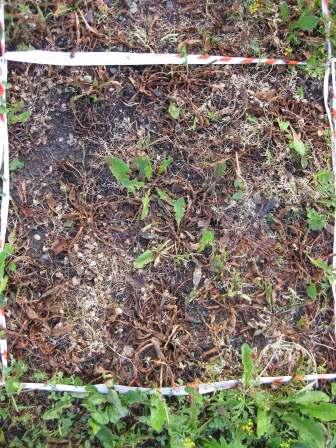
Above is the Round-up treatment a week or so after application.

And here’s the Round-up after three weeks.
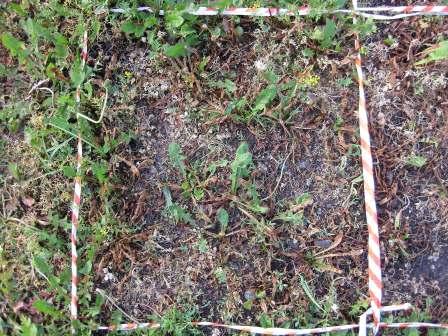
The Vinegar after a few days.
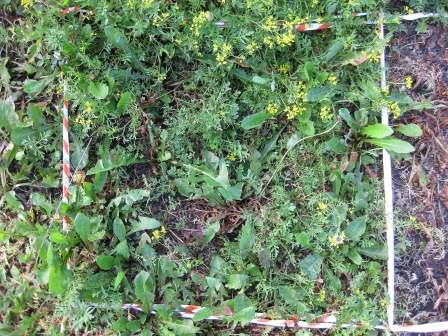
And the vinegar after three weeks.
Vinegar is great for little weeds, but boy oh boy, once they grow up, vinegar just doesn’t do it.